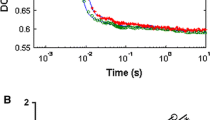Summary
Intracellular Pb2+ ions can replace Ca2+ ions in stimulating the Ca-dependent K permeability of human red blood cells. In metabolically depleted resealed ghosts, the threshold for stimulation of86Rb efflux by internal Pb2+ is around 5×10−10 m, and stimulation is half-maximal at about 2×10−9 m, and maximal at 10−8 m Pb2+. There is no effect on22Na efflux in this concentration range.86Rb efflux is antagonized by internal Mg2+ ions, and by the channel-blocking drugs quinidine and diS-C2(5), as observed for the Ca-dependent K permeability in red cells. In ghosts containing EDTA, which prevents any internal effects of Pb2+ ions, external Pb2+ increases both22Na and86Rb permeability when its concentration exceeds 6×10−7 m. This effect is seemingly unrelated to the Ca-dependent K permeability. This work makes extensive use of Pb2+ ion buffers, and gives information about their preparation and properties.
Similar content being viewed by others
References
Armando-Hardy, M., Ellory, J.C., Ferreira, H.G., Fleminger, S., Lew, V.L. 1975. Inhibition of the calcium-induced increase in the potassium permeability of human red blood cells by quinine.J. Physiol. (London) 250:32P-33P
Barltrop, D., Smith, A. 1971. Interaction of lead with erythrocytes.Experientia 27:92–93
Bers, D.M. 1982. A simple method for the accurate determination of free [Ca] in Ca-EGTA solutions.Am. J. Physiol. 242:C404-C408
Bodemann, H., Passow, H. 1972. Factors controlling the resealing of the membrane of human erythrocyte ghosts after hypotonic hemolysis.J. Membrane Biol. 8:1–26
Campi, E., Ostacoli, G., Meirone, M., Saini, G. 1964. Stability of the complexes of tricarballylic and citric acids with bivalent metal ions in aqueous solution.J. Inorg. Nucl. Chem. 26:553–564
García-Sancho, J., Sanchez, A., Herreros, B. 1982. All-or-none response of the Ca2+-dependent K+ channel in inside-out vesicles.Nature (London) 296:744–746
Gárdos, G. 1959. The role of calcium in the potassium permeability of human erythrocytes.Acta Physiol. Hung. 15:121–125
Grigarzik, H., Passow, H. 1958. Versuche zum Mechanismus der Bleiwirkung auf die Kaliumpermeabilität roter Blutkörperchen.Pfluegers Arch. 267:73–92
Irving, H.M.N.H., Miles, M.G. 1966. Aryl derivatives of nitrilotriacetic acid, and the stability of their proton and metal complexes.J. Chem. Soc. (A) 727–732
Joyce, C.R.B., Moore, H., Weatherall, M. 1954. The effects of lead, mercury, and gold on the potassium turnover of rabbit blood cells.Br. J. Pharmacol. 9:463–470
Kivalo, P., Virtanen, R., Wickstrom, K., Wilson, M., Pungor, E., Horvai, G., Toth, K. 1976. An evaluation of some commercial lead(II)-selective electrodes.Anal. Chim. Acta 87:401–409
Latorre, R., Miller, C. 1983. Conduction and selectivity in potassium channels.J. Membrane Biol. 71:11–30
Lew, V.L., Ferreira, H.G. 1978. Calcium transport and the properties of a calcium-activated potassium channel in red cell membranes.Curr. Top. Membr. Transp. 10:217–271
Lew, V.L., Muallem, S., Seymour, C.A. 1982. Properties of the Ca2+-activated K channel in one-step inside-out vesicles from human red cell membranes.Nature (London) 296:742–744
Marty, A. 1983. Ca2+-dependent K+ channels with large unitary conductance.Trends Neurosci. 6:262–265
Ørskov, S.L. 1935. Untersuchungen über den Einfluss von Kohlensäure und Blei auf die Permeabilität der Blutkörperchen für Kalium und Rubidium.Biochem. Z. 279:250–261
Ørskov, S.L. 1947. The volume of the erythrocytes at different osmotic pressure. Further experiments on the influence of lead on the permeability of cations.Acta Physiol. Scand. 12:202–212
Passow, H. 1981. Selective enhancement of potassium efflux from red blood cells by lead.In: The Function of Red Blood Cells: Erythrocyte Pathobiology. D.F.H. Wallach, editor. pp. 79–104. Alan R. Liss, New York
Passow, H., Tillmann, K. 1955. Untersuchungen über Kaliumverlust bleivergifteter Menschenerythrocyten.Pfluegers Arch. 262:23–36
Porzig, H. 1975. Comparative study of the effects of propranolol and tetracaine on cation movements in resealed ghosts.J. Physiol (London) 249:27–49
Riordan, J.R., Passow, H. 1971. Effects of calcium and lead on potassium permeability of human erythrocyte ghosts.Biochim. Biophys. Acta 249:601–605
Riordan, J.R., Passow, H. 1973. The effects of calcium and lead on the potassium permeability of human erythrocytes and erythrocyte ghosts.In: Comparative Physiology. L. Bolis, K. Schmidt-Nielsen and S.H.P. Maddrell, editors. pp. 543–581. North-Holland, Amsterdam
Schwarzenbach, G., Anderegg, G., Schneider, W., Senn, H. 1955. Komplexone XXVI. Über die Koordinationstendenz von N-substituierten Iminodiessigsäuren.Helv. Chim. Acta 38:1147–1170
Schwarzenbach, G., Freitag, E. 1951. Komplexone XIX. Die Bildungskonstanten von Schwermetallkomplexen der Nitrilo-triessigsäure.Helv. Chim. Acta 34:1492–1502
Sillén, L.G., Martell, A.E. 1964. Stability Constants of Metal-Ion Complexes. The Chemical Society, London
Simons, T.J.B. 1976a. The preparation of human red cell ghosts containing calcium buffers.J. Physiol. (London) 256:209–225
Simons, T.J.B. 1976b. Calcium-dependent potassium exchange in human red cell ghosts.J. Physiol. (London) 256:227–244
Simons, T.J.B. 1979. Actions of a carbocyanine dye on calcium-dependent potassium transport in human red cell ghosts.J. Physiol. (London) 288:481–507
Simons, T.J.B. 1983a. The influence of lead ions on red cell cation permeability.J. Physiol. (London) 343:91P-92P
Simons, T.J.B. 1983b. The transport of lead ions across human red cell membranes.J. Physiol. (London) 345:108P
Simons, T.J.B. 1984. Active transport of lead by human red blood cells.FEBS Lett. 172:250–254
Author information
Authors and Affiliations
Rights and permissions
About this article
Cite this article
Simons, T.J.B. Influence of lead ions on cation permeability in human red cell ghosts. J. Membrain Biol. 84, 61–71 (1985). https://doi.org/10.1007/BF01871648
Received:
Revised:
Issue Date:
DOI: https://doi.org/10.1007/BF01871648



